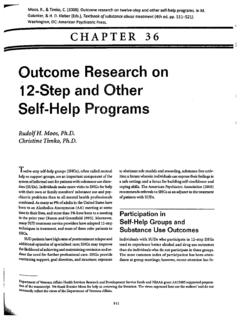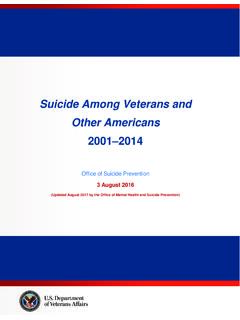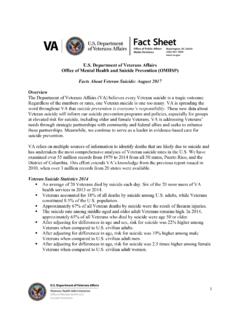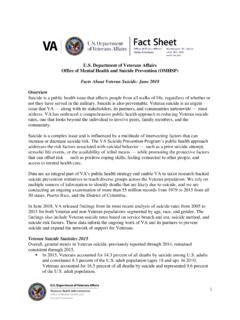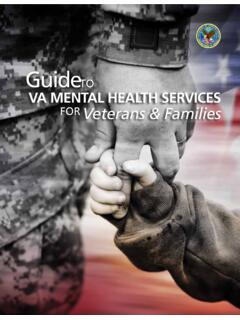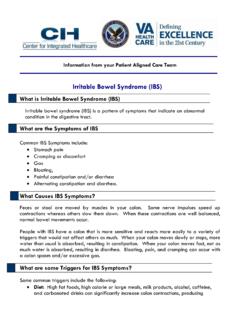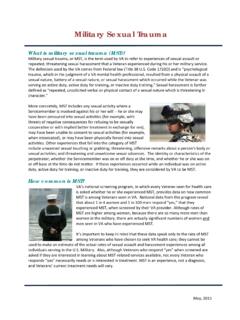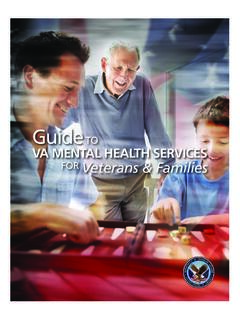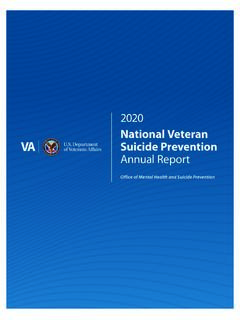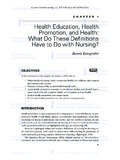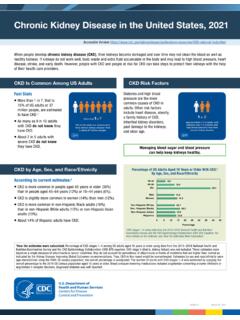Transcription of My Smoking Workbook Revised 2017 - Mental Health Home
1 My To b a c c oCessationWorkbook A Resource for VeteransMy To b a c c oCessationWorkbook A Resource for VeteransAcknowledgementsThe provider manual Primary Care & Tobacco Cessation and the accompanying My Tobacco Cessation Workbook were developed by Julianne Himstreet, , BCPS. The author s primary goal was to develop materials promoting tobacco cessation interventions, based on published principles of evidence- and consensus-based clinical practice, for use by primary care providers treating patients who use permission from the HIV and Smoking Cessation (HASC) Working Group, several materials used in the Primary Care & Tobacco Cessation provider manual were modified from HIV Provider Smoking Cessation Handbook. The Public Health Service Clinical Practice Guideline (Fiore, 2000) and the treatment model described by Richard Brown (2003) provided the foundation for their work and therefore indirectly ours as thanks to Kim Hamlett-Berry, Director of Tobacco & Health Policy in VHA Office of Mental Health Services, for supporting this project and Leah Stockett for editing the manual and the Workbook .
2 In addition, much appreciation needs to be given to Dana Christofferson, Kim Hamlett-Berry, Pam Belperio, and Tim Chen for their editing and content Brown, (2003). Intensive behavioral treatment. In D. B. Abrams, R. Niaura, R. Brown, K. M. Emmons, M. G. Goldstein, & P. M Monti, The tobacco dependence treatment handbook: A guide to best practices (pp. 118-177). New York, NY: Guilford Press. Fiore, M. C. Bailey, W. C., Cohen, S. J., Dorfman, S. F., Goldstein, M. G., Gritz, E. R., Heyman, R. B., Ja n, C. R., Kottke, T. E., Lando, H. A., Mecklenburg, R. E., Mullen, P. D., Nett, L. N., Robinson, L., Stitzer, M. L., Tommasello, A. C., Villejo, L., & Wewers, M. E. (2000). Treating tobacco use and dependence. Clinical practice guideline. Rockville, MD: Department of of ContentsCHAPTER 1: Introduction ..1 Why Do I Want To Quit Tobacco? ..3 Why Do I Use Tobacco Products? ..4 Barriers To Quitting ..5 CHAPTER 2: Why Do I Use Tobacco? ..7 Tobacco Use Is Linked To Other Habits.
3 8A Challenge For You: Addressing Your Triggers ..9 CHAPTER 3: Nicotine Addiction ..17 What Is Nicotine? ..18 Coping With Nicotine Withdrawal ..19 How Tobacco Affects Your Body ..23 Secondhand Smoke ..25 Recovery Of Your Body After Stopping Tobacco ..26 CHAPTER 4: Medications To help You Quit Tobacco ..29 Types Of Tobacco Cessation Medications ..30 Nicotine Replacement Therapy (NRT) ..31 Bupropion (Zyban , Wellbutrin )..35 Varenicline (Chantix ) ..36 Medications Affected By Smoking ..39 CHAPTER 5: Getting Ready For Quit Day! ..41 Set Your Quit Day ..42 Planning For Quit Day ..43 Stress And Tobacco Use ..46 Cravings For Tobacco: What Do I Do? ..47 Get help From Family And Friends ..48 CHAPTER 6: Quit Day ..51 What To Do On Quit Day ..52 Handling Nicotine Cravings ..53iTable of Contents (cont.) Exercise .. 53 Healthy Eating .. 55 CHAPTER 7: The First Two Weeks After Quit Day .. 57 Benefits Of Quitting .. 58 Reward Yourself .. 59 CHAPTER 8: How Do I Stay Off Tobacco?
4 63 Watch Out For Triggers .. 64 Resist The Urges .. 64 Planning For The Future .. 65 Slip Prevention .. 66 CHAPTER 9: Living Tobacco Free .. 71 Stay Tobacco Free .. 72 Dealing With Stress .. 74 CHAPTER 10: Appendices .. 77 Appendix A: Deep Breathing Exercises .. 78 Appendix B: Progressive Muscle Relaxation And Body Scan .. 80 Appendix C: Tobacco Cessation Resources .. 82 Appendix D: Frequently Asked Questions .. 84 ii 1 Introduction2 Why Do I Use Tobacco?3 Nicotine Addiction4 Medications To help You Quit Tobacco5 Getting Ready For Quit Day!6 Quit Day7 The First Two Weeks After Quit Day8 How Do I Stay Off Tobacco?9 Living Tobacco Free10 AppendicesCHAPTER 1: Introduction1. Why Do I Want To Quit Tobacco?2. Why Do I Use Tobacco Products?3. Barriers To Quitting1 CHAPTER 1: IntroductionCongratulations on taking the first step to quitting tobacco products. Whether you smoke cigarettes, cigars, pipes or use chewing tobacco, VA s Primary Care Tobacco Cessation Program can help you quit.
5 Smoking is the number one cause of preventable illness in the United States. Smoking increases your chance of heart attacks and strokes and it can damage your lungs and in many cases, lead to emphysema. Smoking and tobacco use can also cause cancer of the lungs, bladder, kidney, and pancreas as well as in the mouth and you have tried to quit before and have not been successful, don t give up! Research has shown that it takes an average of 6-8 quit attempts for a smoker to quit for good. Think of this as a chronic disease like high blood pressure or high will need to work to get tobacco out of your life for what is the best way to quit tobacco? People ask this question all the time and there are multiple ways you can stop. The best way to stop tobacco is to use behavioral techniques to help you break the habit and develop new behaviors, along with medications to manage nicotine withdrawal symptoms. This manual, written specifically for Veterans, will assist you in changing your daily behaviors that up until now have resulted in your use of tobacco 1: IntroductionCHAPTER 1: IntroductionWHY DO I WANT TO QUIT TOBACCO?
6 The first step in quitting any addictive drug, including nicotine, is to determine why you want to off the reasons you want to quit tobacco products: Breathe betterReduce my risk of cancerReduce my risk of emphysema/chronic bronchitis, chronic obstructive pulmonary disease (COPD)Improve circulation of blood to my legs and armsReduce my risk of heart attack and strokeSmell betterImprove my sense of smell and tasteSave moneySet a good example for my children/grandchildrenHave more control over my lifeWhat are other reasons you want to quit? Write these reasons below:_____3 WHY DO I USE TOBACCO PRODUCTS?The next step is to look at why you smoke or chew tobacco. It is okay to admit that you like it. Most people who use tobacco like something about it, whether it is the feeling when the nicotine hits your brain, or the taste or off the reasons you use tobacco products: Reduces stress Relieves boredom I just do it! I like it Something to do during break time Reward for completing a task Celebrating something Socializing Relieves anxiety I have nightmares or difficulty sleepingWhat are other reasons you use tobacco?
7 Write these reasons below:_____CHAPTER 1: Introduction4 Now look at your reasons for using tobacco and the reasons why you want to quit. Do the reasons to quit outweigh the reasons to continue tobacco use? If the answer is yes, then you are ready to head to the next step: preparing to quit TO QUITTINGHave you tried to quit tobacco in the past? If the answer is yes, then think about what caused you to relapse. This could be a barrier you may need to address in this quit attempt. Think about your barriers to quitting like a speed bump that may get in your way of quitting successfully. If you are able to address these barriers, you can increase your chances of quitting tobacco. These barriers can sometimes become a backdoor that you leave open to justify your return to tobacco. To stop for good, it is important to close all of these backdoors so you have no reason to return to each of the following barriers you may have to stopping tobacco:I tried to quit in the past, but it never workedI live with other people who are still using tobaccoI am concerned about weight gainI don t know what to do without a cigarette or a chewHow will I socialize with my friends who still smoke/chew?
8 I am worried about how I will handle stress I have a cigarette with my coffee. I am not sure if I can enjoy coffee without a usually have a cigarette when I have a beer. It is hard to separate the smoke when I am boredI am afraid it will make my stress, anxiety, or mood worseI can t get back to sleep unless I smoke oneIt is the only vice I have have quit everything elseI don t know how to say no Write in other barriers you have to quitting tobacco:_____CHAPTER 1: Introduction51 Introduction2 Why Do I Use Tobacco?3 Nicotine Addiction4 Medications To help You Quit Tobacco5 Getting Ready For Quit Day!6 Quit Day7 The First Two Weeks After Quit Day8 How Do I Stay Off Tobacco?9 Living Tobacco Free10 AppendicesCHAPTER 2: Why Do I Use Tobacco?1. Tobacco Use Is Linked To Other Habits 72. A Challenge For You: Addressin gYo u r Tr ig g e r sCHAPTER 2: Why Do I Use Tobacco?TOBACCO USE IS LINKED TO OTHER HABITST obacco use is associated with several different behaviors that are very closely related.
9 Tobacco use is a learned behavior, meaning you learned this from your family, friends, magazine ads, television, movies, or during your military service. When you were in the military, you may have heard someone say Smoke em if you got em. Who helped you learn your tobacco habit?Think about how often you puff or drag on a cigarette in a day. If you smoke one pack of cigarettes a day and each cigarette takes 10 puffs, that s 200 puffs a day. Over the course of 40 years, you would take approximately three million puffs!Table 1. My Tobacco UseExampleMy ExperienceIf you smoke 1 pack per day I smoke ____ packs/cigarettes per dayEstimate 10 puffs on each cigarette Estimate 10 puffs on each cigarette10 puffs/cigarette x 20 cigarettes/day = 200 puffs each day 10 puffs/cigarette x ___ cigarettes/day= ____ puffs each dayTobacco use is also a triggered behavior, meaning certain activities or times of day may make you think about having a cigarette or chewing off some of your triggers for using tobacco: Waking up in the morning After meals During breaks Driving Talking on the phone Working on the computer Drinking coffee Drinking alcoholAfter sexBefore bedtimeWaking up during the night, having nightmares Stress Pain8 CHAPTER 2: Why Do I Use Tobacco?
10 Feeling anxious, angry or impatientSeeing someone else smokeFeeling boredWatching TVAfter completing a taskWrite down other triggers you may have:_____A CHALLENGE FOR YOU: ADDRESSING YOUR TRIGGERSTry not using tobacco during one of your triggers. For example, you might pick after eating breakfast as the trigger. Starting tomorrow, try not Smoking for 10 minutes after breakfast. Wait 20 minutes to smoke after breakfast the next day. Wait 30 minutes the day after that. Add another 10 minutes each day. By the end of the week you will be waiting one hour between the trigger and Smoking . Once you have tackled one trigger, try adding another trigger until you have a few of them managed. By adding time between the trigger and the action of using tobacco, the trigger becomes weaker. This will help when you get to your quit day. If you use chewing tobacco, you can do the same thing by looking at your triggers to put in a new dip. To help you avoid using tobacco, come up with a few things you can do rather than use examples would be: Going for a walk Using a substitute like chewing gum orcandy Doing deep breathing exercisesA more complete list of substitute behaviors can be found under DEADS Strategy on 2: Why Do I Use Tobacco?
